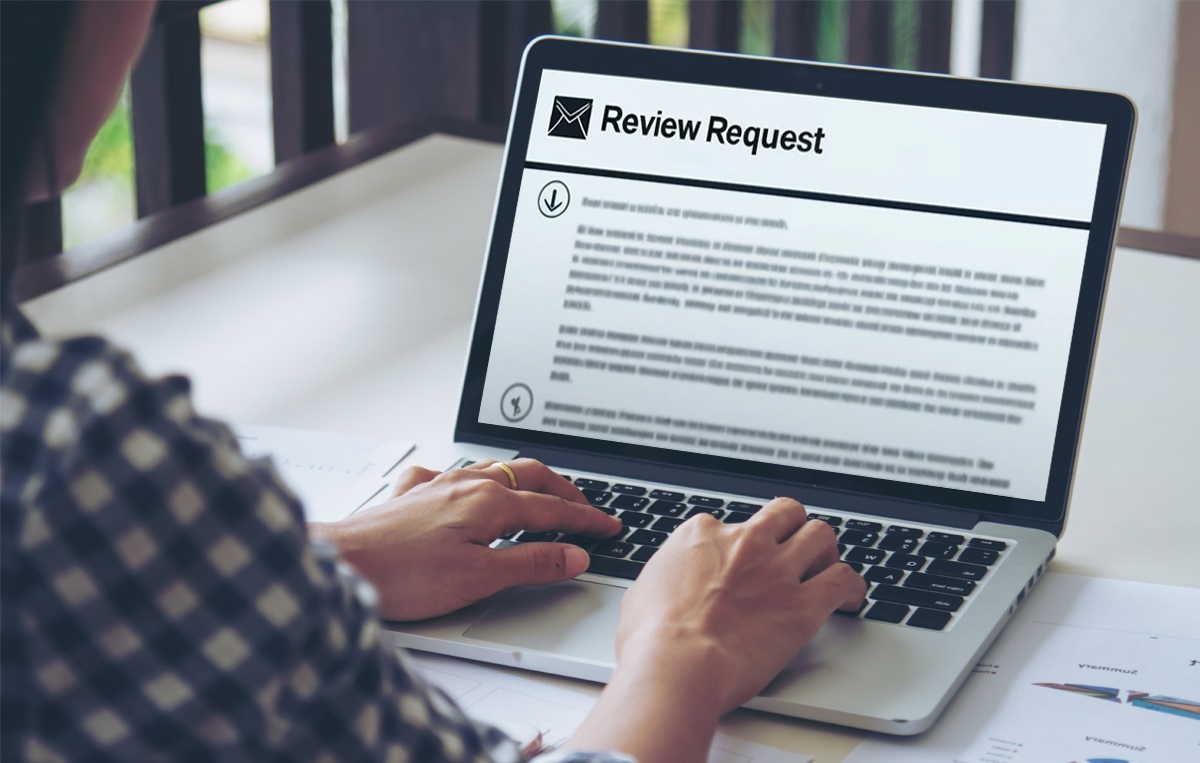Negative reviews can pop up anytime on review sites such as Google Reviews and Yelp or on social media platforms such as Facebook. Dealing with these reviews is a daunting task, especially when most businesses do not know how to respond to negative reviews.
However, the important thing to understand is that customers’ negative feedback is not just criticism; it is an opportunity for you. Responding to negative reviews can enhance your reputation and show prospective customers that you’re responsive, dedicated to continuous improvement, and care about the experience.
In this blog, we’ll explore the best practices for responding to bad reviews, turning potential setbacks into opportunities for growth, and improving your customer relationships.
4 Reasons Why You Should Respond to Negative Reviews from Customer
When customers post a bad review, they expect a quick response. About 53% of customers expect companies to respond to negative reviews in a week. If you respond satisfactorily to a negative review, 52% of consumers would happily continue to do business with you. However, if you continue to ignore the negative reviews, 57% of customers will turn their backs on you.
That is why ignoring bad reviews should not be your habit. Ignoring or deleting them will damage the relationship between you and the unsatisfied consumers. Even if the reviews are false, harsh, or brutal, you must always make a habit of responding to them.
The following are some important benefits of responding to negative reviews:
1. Show That You Care
Customers share their bad experiences on review platforms not only to vent their frustrations but also to grab your attention, receive an apology, and more.
Unhappy customers want you to listen to them and do something about their problems. Responding to a negative comment from a customer proves that you care about their time and opinions.
With your reply to a negative review, you are not just talking to the person who wrote it. You’re speaking to everyone who reads it, including potential customers. By showing that you take customer concerns seriously and are proactive in resolving issues, you reassure others of your commitment to customer satisfaction.
As a business owner, it’s an opportunity to show that you care about your customers and are dedicated to making things right.
2. Resolve Issues to Regain Trust
When you respond to negative reviews, it is not just about the complaint, it is a chance to fix any issues and regain customers trust. Resolve the customer complaints you receive online as if the customers have walked in-person to you to voice their concerns. In such a case, you would probably do all it takes to satisfy the customer. Apply the same principle to the negative feedback you receive online.
When you respond to dissatisfied customers, you show them that you care about their association with the brand and that their feedback and complaints matter to the business. This commitment to problem-solving turns a negative situation into a positive one, eventually helping to win back customers’ trust in your business.
3. Build SEO and Online Reputation
Did you know that replying to reviews can also impact your Search Engine Optimization (SEO) because it gives a perception to search engines like Google that you regularly engage with your customers and care about them?
Also, replying to all kinds of customer reviews adds fresh content to your business listing, which helps to improve your search engine rankings. Including relevant keywords and consistently updating your listing with new content makes it appealing to search engines. This activity enhnances the visibility, local SEO and also attracts more potential customers towards your business.
4. Control the Narrative
Answering reviews gives you an opportunity to put out your side of the story of the incident. It helps you to prove your innocence in cases if the review is false or partially inaccurate. It lets you clear any misunderstandings or conversations surrounding a negative experience.
That way, other customers who come across your page and see negative reviews can read your account of the story and judge for themselves. It’ll become like a testimonial of what your business is.
If you present the facts and showcase your business’s benefits simultaneously, you can turn a negative situation into a positive one.
How to Reply to a Negative Review (7 Best Practices)
How you handle negative reviews tells a lot about your business. Simply responding isn’t enough; what you say and how you say it matters greatly.
Responding to negative reviews speaks volumes about your business. Simply responding isn’t enough; what you say and how you say it matters greatly. Wondering how to respond effectively? Here’s what you need to know:
1. Give Prompt Response
What do you do when you receive a negative Facebook review or a bad review on Google or Yelp? As a business owner, you definitely do not ignore it. In fact, you need to be prompt with your review response to show that, as a business, you are concerned about what customers have to say about you.
It is wrong to believe that unhappy customers can not be brought back. If you respond promptly and appropriately to the customer’s review, they are more likely to give you a second chance. You must attempt to generate goodwill with the customers with each review response. This will enhance your chance of winning them back.
As a matter of fact, 86% of consumers do not feel comfortable purchasing from a brand with negative reviews. So, the longer you leave a negative review without a response, the more time it gets to sway potential customers away while further eroding the trust in your business. Therefore, as a rule, you must respond back to a negative review within 7 days, if not sooner.
But how do you make sure that all reviews, especially negative ones, come to your attention quickly? After all, you have so many platforms and reviews to manage. You need to use a review management tool such as SocialPilot. Go ahead and ace your brand reputation management game.
Struggling with managing your customer reviews across various review platforms?
Let Reviews by SocialPilot help you actively manage your online reputation. Get a centralized platform to monitor, analyze, and respond to customer reviews from multiple online platforms, all in one place.
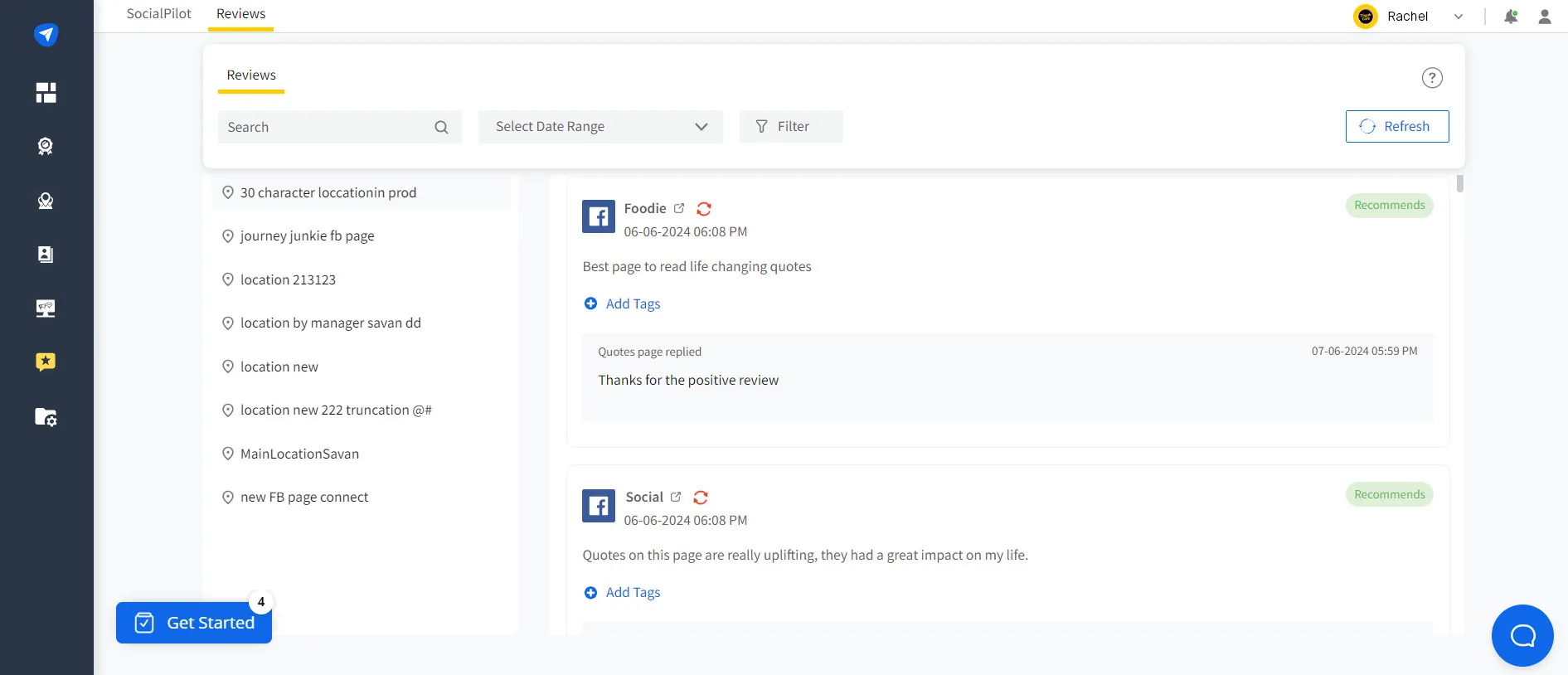
Start Your 14-day Trial
2. Keep a Professional Approach
Online reviews could get mean.
If a customer bashes you in an online review, it is obvious that you feel bad and maybe be angry about it. After all, you work really hard for your business. It may not be an easy pill to swallow, but this is the time when you need to be calm and cool before you get to the bottom of the issue and respond back to the customer’s feedback.
Keep a professional tone in your interactions. Remember that your potential customers will be reading the review and your response to it. Your professional and polite response and focus on understanding customers’ issues will put your business in a better light.
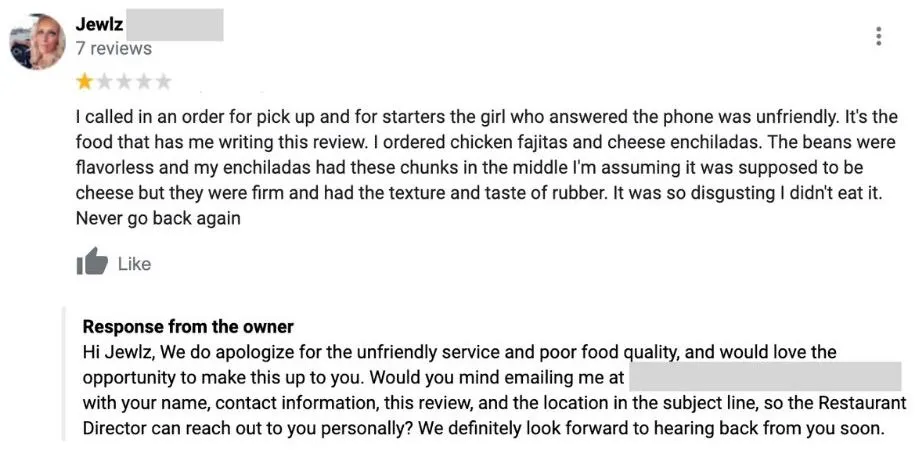
You can use the following phrases when responding to negative reviews:
- Thank you for bringing this to our attention. We apologize for any inconvenience you may have experienced and would like to make things right.
- We appreciate your feedback and are sorry to hear about your experience. Please contact us directly so we can address your concerns personally.
- We’re sorry to hear that your experience did not meet your expectations. Your feedback helps us improve, and we would like to discuss this further with you.
These phrases show that you are empathetic and willing to resolve the issues and also committed to better the customer experience. They will definitely help you respond to negative reviews.
3. Acknowledge the Issue and Apologize
Do not underestimate the power of acknowledging and apologizing for an issue. It is all it takes to pacify an anguished customer. About 45% of consumers remove negative reviews if the business acknowledges the issue, apologizes, and offers a solution.
Here are 4 steps that will help you acknowledge a customer complaint and help win back their trust:
Step 1: Thank the Customer
Start by thanking the customer and appreciate them for taking out time to leave a review.
Sample Phrase: “Thank you for bringing this to our attention. We appreciate you taking the time to share your experience with us.”
Step 2: Acknowledge the Problem
Get to the point and address the issues the customers are facing. Validate the feelings of the customers without necessarily admitting the blame.
Sample Phrase: “We understand your frustration and regret that your experience did not meet your expectations.”
Step 3: Apologize to the Customer
Offer a simple yet empathetic apology for the inconvenience caused to the customer. This must show that you care about them.
Sample Phrase: “We apologize for any inconvenience you may have faced. (Business Name) is committed to resolving this matter.”
Step 4: Take the Conversation Offline
Encourage the customer to contact you one-on-one, either in-store or over a phone or video call. This will display a willingness to make things right.
Sample Phrase: “Please contact us directly so we can address your concerns personally and work towards a solution.”
Remember that while a simple apology goes a long way, you must follow through on your promise to resolve the complaint.
4. Personalize Your Response
When responding to a negative review, personalizing your response can make a big difference. Address the customer by their name instead of using generic salutations like “Dear guest” or “Dear customer.” In addition, you should specifically mention the issues they mentioned, such as poor food quality or slow service.
This shows that you’ve read the review carefully and take customer feedback seriously. Avoid justifying the issues or making excuses. Instead, reassure the reviewer that you’ll be making adjustments moving forward to improve their experience.
By personalizing your response to the negative reviews, you show that you genuinely care about each customer’s concerns and are committed to making positive changes.
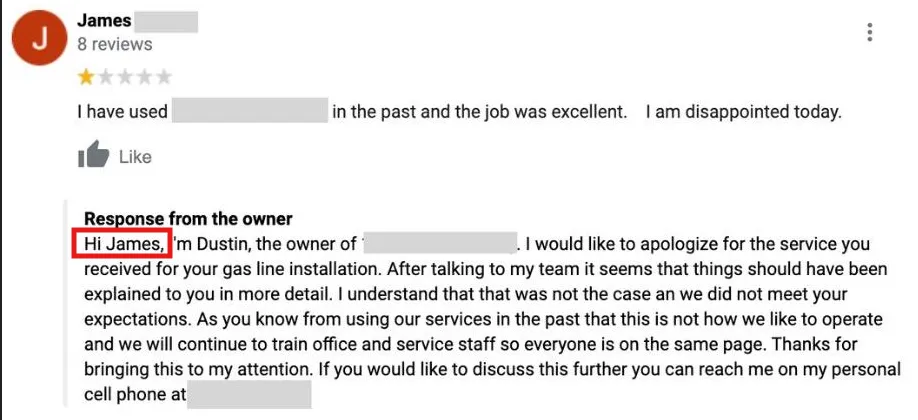
5. Take Conversation Offline
In some instances, the best way to help a dissatisfied customer is to talk to them privately. This can be really helpful if the customer feels disrespected or a serious altercation arises in the online conversation.
If the issue has escalated badly on social media, take it privately rather than commenting back and forth. It is more appropriate to call the customer directly or send them a private message to try to amend their bad experience.
This gesture can go a long way in satisfying an unhappy customer. You just need to ask your customer support team to talk to the customer via direct message or provide the reviewer with an email ID or phone number so they can reach you to discuss their concern further and get a quick resolution.
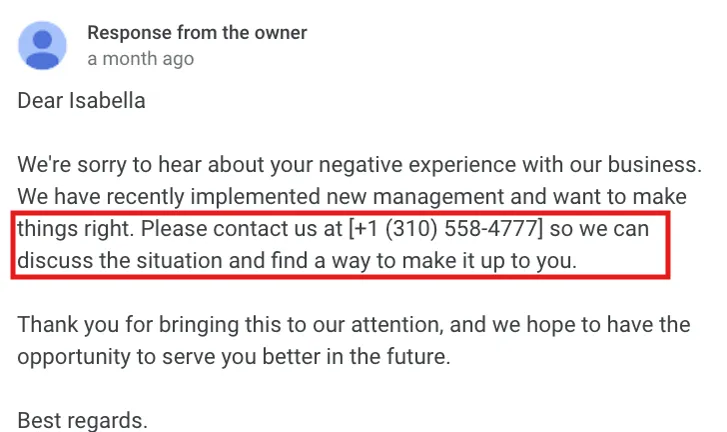
6. Offer a Solution
Acknowledging the issue and apologizing is just the beginning. An apology is not enough if the customer is left dry in the end. Until you offer the customers a solution or compensation for the issues they have faced, you can not expect the negative experience to go away.
The solution could include a refund, replacement, discount, free service, or whatever is appropriate for a given situation.
You can use the following sample phrase when extending the solution to the customer:
“We apologize for the inconvenience you experienced with our service. To make it right, we’d like to offer you a 20% discount on your next visit. Please contact us directly so we can arrange this for you.”
Offering a tangible solution shows your commitment to resolving the issue and improving customer experience.
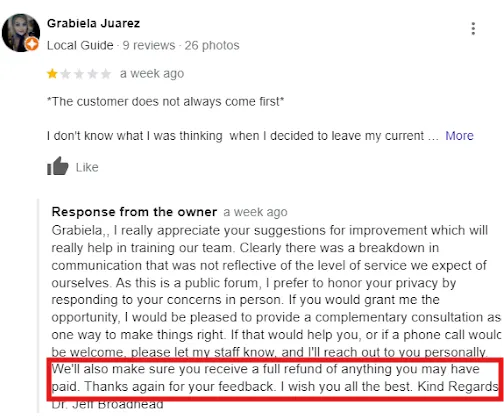
7. Follow-Up With the Negative Reviewer
A shocking 97% of businesses do not send a follow up email to the customers to check if they are satisfied with their review response or not.
Following up is crucial as it shows you genuinely care about resolving their issues and value their feedback. This can be done through emails, phone calls, or messages. For larger businesses, assigning this task to the customer service team ensures that no customer concern goes unnoticed.
Regular follow-ups can significantly enhance customer satisfaction and loyalty, turning a negative experience into a positive one.
Examples of How to Respond to Negative Reviews
When responding to customers’ negative reviews, it’s important to align your approach with your brand’s tone. Whether you choose a formal, casual, or moderate style depends on your brand’s identity and how you typically communicate with your audience.
Stop worrying about how to deal with negative reviews. Here are a few examples of negative review responses that can help you write good responses for multiple businesses.
1. Formal Response to Negative Review
Hello (Reviewer’s Name),
We sincerely apologize for the bad experience and any inconvenience it caused. Your satisfaction is our top priority, and we appreciate you bringing this to our attention.
Please accept our apologies for not meeting your expectations. We’d like to make things right. Could you contact us directly at (contact information)? We’d love to discuss your experience further and find the best solution.
Thank you for your feedback. We hope to have the opportunity to regain your trust.
2. Casual Response to Negative Review
Hey (Reviewer’s Name),
Sorry things didn’t go as expected. We’re sorry and are here to help!
Your happiness means a lot to us, and we seek an opportunity to fix the problem and win back your trust. Can you write us a message at (contact information)? We’d like to talk more to understand what happened and how we can solve it.
3. Addressing Slow Service
Hello (Reviewer’s Name),
Thank you for bringing this to our attention. We sincerely apologize for the slow service you experienced and any inconvenience it caused. This does not reflect our usual standards, and we will address this issue with our team immediately. To make amends, we would like to offer you a 20% discount on your next visit. Please contact us at (contact info) to arrange this.
We appreciate your feedback and hope to serve you better in the future.
4. Responding to Product Quality Issues
Hello (Reviewer’s Name),
Thank you for letting us know about the issue with your order. We are truly sorry for the inconvenience this has caused. Please contact our customer service at (contact info) so we can arrange a replacement or a full refund for you.
Your satisfaction is our top priority, and we appreciate your feedback to help us improve.
5. Handling Cleanliness Complaints
Hello (Reviewer’s Name),
We’re really sorry about the cleanliness issues you encountered during your stay. This definitely isn’t the experience we aim to provide. Please reach out to us at (contact information) so we can offer you a discount during your next stay to make up for this.
Thanks for bringing this to our attention – we’re on it!
6. Addressing Food Quality Concerns
Hello (Reviewer’s Name),
We thank you for taking out time to share your honest feedback. We apologize that your meal did not meet your expectations. We are reviewing our food preparation processes to prevent this from happening again.
As an apology, we would like to invite you back for a complimentary meal. Please contact us at (contact info) to let us arrange this for you. We appreciate your feedback and look forward to serving you better.
7. Responding to Delivery Issues
Hello (Reviewer’s Name),
We’re really sorry about the delay and missing items in your order. That’s definitely not what we aim for. Please reach out to us at (contact info) or send a message in our personal chat so we can sort this out, send you the missing items, or discuss any alternate solutions. Thank you for your patience and for letting us know.
Conclusion
“Your brand name is only as good as your reputation.” – Richard Branson
The quote accurately sums up the importance of maintaining a good brand reputation for any business. A positive reputation builds trust and loyalty among customers, influences purchasing decisions, and sets you apart from competitors.
Negative reviews, though bad, can be an opportunity for your brand to show your commitment to customer service and satisfaction. In this blog, we have shared techniques with you to help you do just that. These best practices and free negative review response examples will help you enhance customer satisfaction and win more happy customers.
However, before we go, here are 4 mistakes that you should avoid to enhance the experience of your further dissatisfied consumers:
- Do not lose your temper
- Being too proud to say sorry
- Not responding to negative reviews
- Do not duplicate the same reply
- Do not fall short of providing exceptional customer service
In the age of Google and Yelp reviews, customer feedback can make or break your reputation. So when you reply to a bad review, remember, you are not just speaking to one reviewer; you are responding to all who are reading your review.


